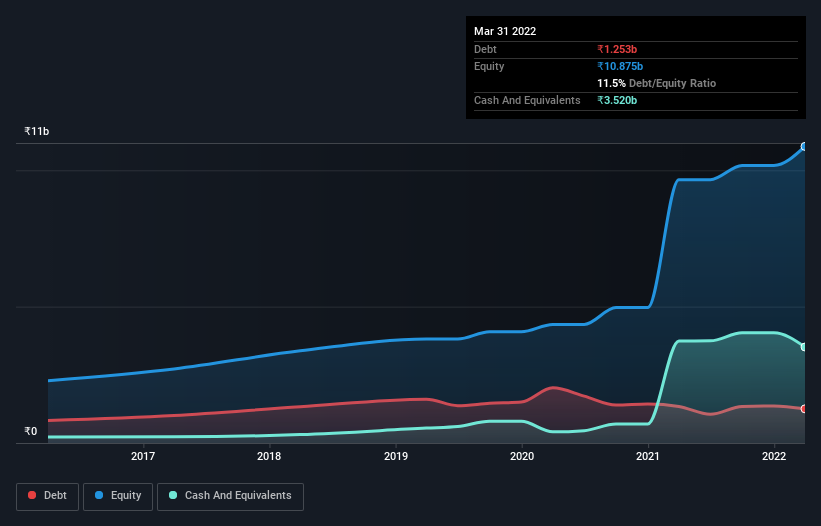- India
- /
- Medical Equipment
- /
- NSEI:POLYMED
Here's Why Poly Medicure (NSE:POLYMED) Can Manage Its Debt Responsibly

Howard Marks put it nicely when he said that, rather than worrying about share price volatility, 'The possibility of permanent loss is the risk I worry about... and every practical investor I know worries about.' When we think about how risky a company is, we always like to look at its use of debt, since debt overload can lead to ruin. We can see that Poly Medicure Limited (NSE:POLYMED) does use debt in its business. But the real question is whether this debt is making the company risky.
Why Does Debt Bring Risk?
Debt assists a business until the business has trouble paying it off, either with new capital or with free cash flow. If things get really bad, the lenders can take control of the business. However, a more frequent (but still costly) occurrence is where a company must issue shares at bargain-basement prices, permanently diluting shareholders, just to shore up its balance sheet. Of course, debt can be an important tool in businesses, particularly capital heavy businesses. When we examine debt levels, we first consider both cash and debt levels, together.
View our latest analysis for Poly Medicure
How Much Debt Does Poly Medicure Carry?
You can click the graphic below for the historical numbers, but it shows that Poly Medicure had ₹1.25b of debt in March 2022, down from ₹1.34b, one year before. However, it does have ₹3.52b in cash offsetting this, leading to net cash of ₹2.27b.

How Strong Is Poly Medicure's Balance Sheet?
The latest balance sheet data shows that Poly Medicure had liabilities of ₹2.27b due within a year, and liabilities of ₹626.8m falling due after that. Offsetting this, it had ₹3.52b in cash and ₹2.07b in receivables that were due within 12 months. So it actually has ₹2.70b more liquid assets than total liabilities.
This surplus suggests that Poly Medicure has a conservative balance sheet, and could probably eliminate its debt without much difficulty. Simply put, the fact that Poly Medicure has more cash than debt is arguably a good indication that it can manage its debt safely.
On the other hand, Poly Medicure saw its EBIT drop by 4.6% in the last twelve months. If earnings continue to decline at that rate the company may have increasing difficulty managing its debt load. When analysing debt levels, the balance sheet is the obvious place to start. But ultimately the future profitability of the business will decide if Poly Medicure can strengthen its balance sheet over time. So if you're focused on the future you can check out this free report showing analyst profit forecasts.
But our final consideration is also important, because a company cannot pay debt with paper profits; it needs cold hard cash. While Poly Medicure has net cash on its balance sheet, it's still worth taking a look at its ability to convert earnings before interest and tax (EBIT) to free cash flow, to help us understand how quickly it is building (or eroding) that cash balance. In the last three years, Poly Medicure created free cash flow amounting to 3.1% of its EBIT, an uninspiring performance. That limp level of cash conversion undermines its ability to manage and pay down debt.
Summing up
While we empathize with investors who find debt concerning, you should keep in mind that Poly Medicure has net cash of ₹2.27b, as well as more liquid assets than liabilities. So we are not troubled with Poly Medicure's debt use. When analysing debt levels, the balance sheet is the obvious place to start. But ultimately, every company can contain risks that exist outside of the balance sheet. Case in point: We've spotted 3 warning signs for Poly Medicure you should be aware of, and 1 of them is a bit unpleasant.
When all is said and done, sometimes its easier to focus on companies that don't even need debt. Readers can access a list of growth stocks with zero net debt 100% free, right now.
New: Manage All Your Stock Portfolios in One Place
We've created the ultimate portfolio companion for stock investors, and it's free.
• Connect an unlimited number of Portfolios and see your total in one currency
• Be alerted to new Warning Signs or Risks via email or mobile
• Track the Fair Value of your stocks
Have feedback on this article? Concerned about the content? Get in touch with us directly. Alternatively, email editorial-team (at) simplywallst.com.
This article by Simply Wall St is general in nature. We provide commentary based on historical data and analyst forecasts only using an unbiased methodology and our articles are not intended to be financial advice. It does not constitute a recommendation to buy or sell any stock, and does not take account of your objectives, or your financial situation. We aim to bring you long-term focused analysis driven by fundamental data. Note that our analysis may not factor in the latest price-sensitive company announcements or qualitative material. Simply Wall St has no position in any stocks mentioned.
About NSEI:POLYMED
Poly Medicure
Manufactures and sells medical devices in India and internationally.
Flawless balance sheet with high growth potential.
Market Insights
Community Narratives



